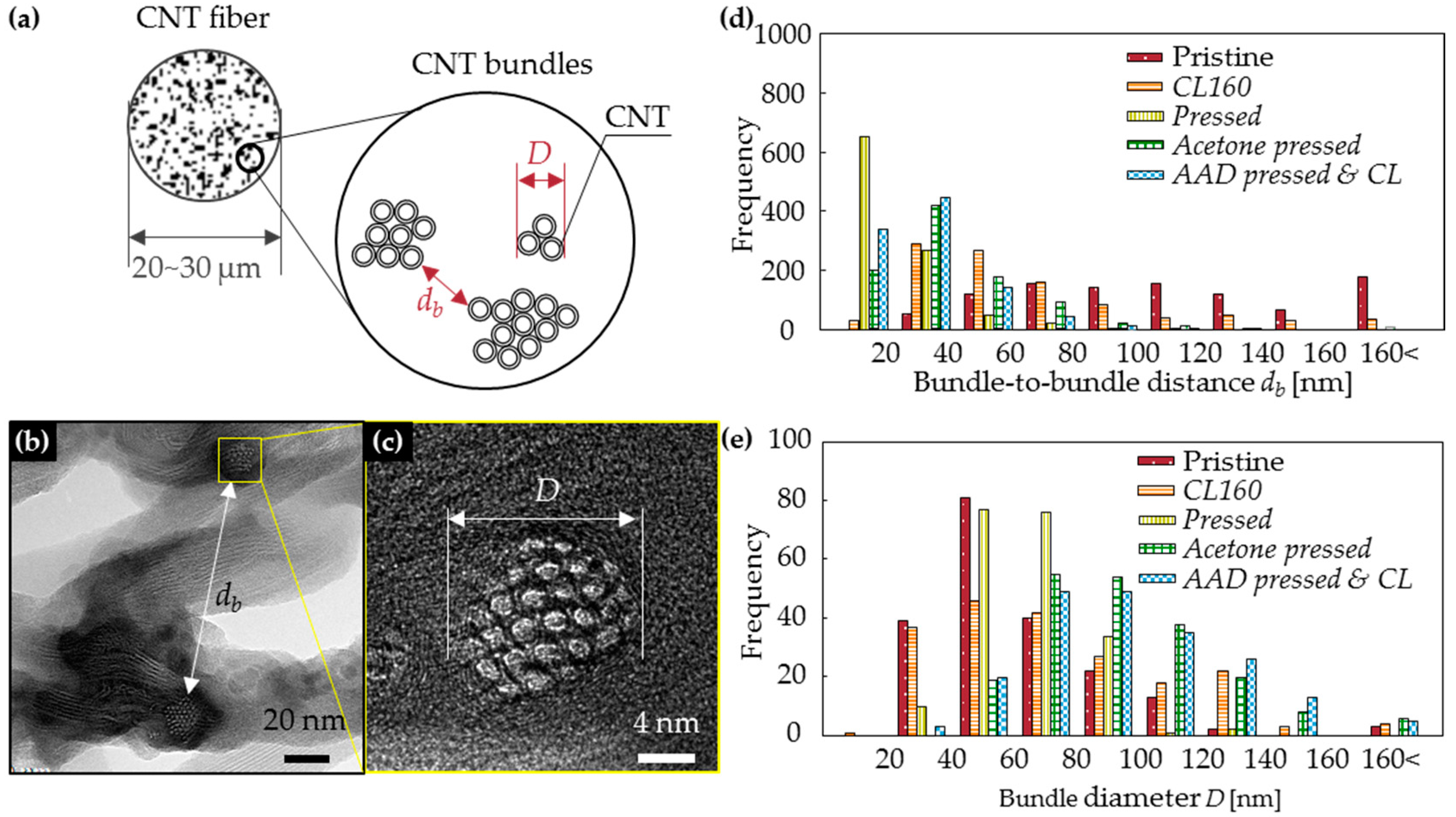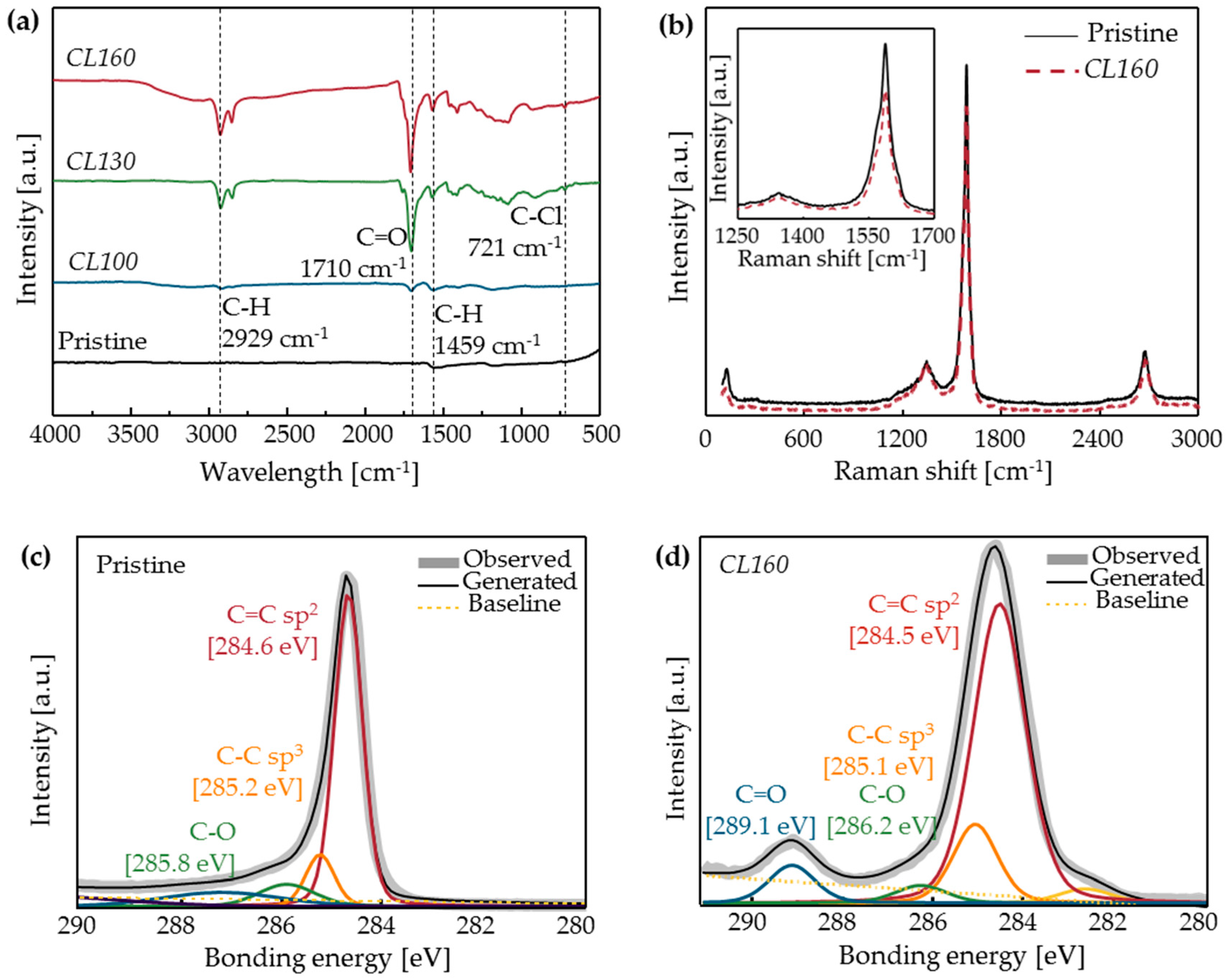Effects of Wet-Pressing and Cross-Linking on the Tensile Properties of Carbon Nanotube Fibers
Abstract
:1. Introduction
2. Materials and Methods
2.1. Materials
2.2. Methods
2.3. Characterization
3. Results and Discussions
3.1. Physical Effects of Roller Pressing and Liquid Injection
3.2. Chemical Cross-Linking
3.3. Tensile Properties
4. Conclusions
Supplementary Materials
Author Contributions
Funding
Acknowledgments
Conflicts of Interest
References
- Thostenson, E.T.; Ren, Z.; Chou, T.-W. Advances in the science and technology of carbon nanotubes and their composites: A review. Compos. Sci. Technol. 2001, 61, 1899–1912. [Google Scholar] [CrossRef]
- Peng, B.; Locascio, M.; Zapol, P.; Li, S.; Mielke, S.L.; Schatz, G.C.; Espinosa, H.D. Measurements of near-ultimate strength for multiwalled carbon nanotubes and irradiation-induced crosslinking improvements. Nat. Nanotechnol. 2008, 3, 626–631. [Google Scholar] [CrossRef] [PubMed]
- Li, Y.-L.; Kinloch, I.A.; Windle, A.H. Direct spinning of carbon nanotube fibers from chemical vapor deposition synthesis. Science 2004, 304, 276–278. [Google Scholar] [CrossRef] [PubMed]
- Yusof, N.; Ismail, A. Post spinning and pyrolysis processes of polyacrylonitrile (PAN)-based carbon fiber and activated carbon fiber: A review. J. Anal. Appl. Pyrolysis 2012, 93, 1–13. [Google Scholar] [CrossRef]
- Vilatela, J.J.; Windle, A.H. Yarn-like carbon nanotube fibers. Adv. Mater. 2010, 22, 4959–4963. [Google Scholar] [CrossRef] [PubMed]
- Tran, T.Q.; Fan, Z.; Liu, P.; Myint, S.M.; Duong, H.M. Super-strong and highly conductive carbon nanotube ribbons from post-treatment methods. Carbon 2016, 99, 407–415. [Google Scholar] [CrossRef]
- Hearle, J. Theoretical analysis of the mechanics of twisted staple fiber yarns. Text. Res. J. 1965, 35, 1060–1071. [Google Scholar] [CrossRef]
- Park, J.; Lee, K.-H. Carbon nanotube yarns. Korean J. Chem. Eng. 2012, 29, 277–287. [Google Scholar] [CrossRef]
- Beese, A.M.; Wei, X.; Sarkar, S.; Ramachandramoorthy, R.; Roenbeck, M.R.; Moravsky, A.; Ford, M.; Yavari, F.; Keane, D.T.; Loutfy, R.O. Key factors limiting carbon nanotube yarn strength: Exploring processing-structure-property relationships. ACS Nano 2014, 8, 11454–11466. [Google Scholar] [CrossRef] [PubMed]
- Duong, H.M.; Gong, F.; Liu, P.; Tran, T.Q. Advanced fabrication and properties of aligned carbon nanotube composites: Experiments and modeling. In Carbon Nanotubes-Current Progress of Their Polymer Composites; IntechOpen: London, UK, 2016. [Google Scholar]
- Khoshnevis, H.; Tran, T.Q.; Mint, S.M.; Zadhoush, A.; Duong, H.M.; Youssefi, M. Effect of alignment and packing density on the stress relaxation process of carbon nanotube fibers spun from floating catalyst chemical vapor deposition method. Colloid Surf. A Physicochem. Eng. Asp. 2018, 558, 570–578. [Google Scholar] [CrossRef]
- Hill, F.A.; Havel, T.F.; Hart, A.J.; Livermore, C. Enhancing the tensile properties of continuous millimeter-scale carbon nanotube fibers by densification. ACS Appl. Mater. Interfaces 2013, 5, 7198–7207. [Google Scholar] [CrossRef] [PubMed]
- Miao, M. The role of twist in dry spun carbon nanotube yarns. Carbon 2016, 96, 819–826. [Google Scholar] [CrossRef]
- Liu, K.; Sun, Y.; Zhou, R.; Zhu, H.; Wang, J.; Liu, L.; Fan, S.; Jiang, K. Carbon nanotube yarns with high tensile strength made by a twisting and shrinkingmethod. Nanotechnology 2009, 21, 045708. [Google Scholar] [CrossRef] [PubMed]
- Di, J.; Fang, S.; Moura, F.A.; Galvão, D.S.; Bykova, J.; Aliev, A.; de Andrade, M.J.; Lepró, X.; Li, N.; Haines, C. Strong, Twist-Stable Carbon Nanotube Yarns and Muscles by Tension Annealing at Extreme Temperatures. Adv. Mater. 2016, 28, 6598–6605. [Google Scholar] [CrossRef] [PubMed]
- Tran, C.-D.; Humphries, W.; Smith, S.M.; Huynh, C.; Lucas, S. Improving the tensile strength of carbon nanotube spun yarns using a modified spinning process. Carbon 2009, 47, 2662–2670. [Google Scholar] [CrossRef] [Green Version]
- Miaudet, P.; Badaire, S.; Maugey, M.; Derre, A.; Pichot, V.; Launois, P.; Poulin, P.; Zakri, C. Hot-drawing of single and multiwall carbon nanotube fibers for high toughness and alignment. Nano Lett. 2005, 5, 2212–2215. [Google Scholar] [CrossRef] [PubMed]
- Cho, H.; Lee, H.; Oh, E.; Lee, S.-H.; Park, J.; Park, H.J.; Yoon, S.-B.; Lee, C.-H.; Kwak, G.-H.; Lee, W.J. Hierarchical structure of carbon nanotube fibers, and the change of structure during densification by wet stretching. Carbon 2018, 136, 409–416. [Google Scholar] [CrossRef]
- Bishop, R. Crystal Engineering. In Kirk-Othmer Encyclopedia of Chemical Technology; John Wiley & Sons, Inc.: Hoboken, NJ, USA, 2000. [Google Scholar]
- Cai, J.Y.; Min, J.; McDonnell, J.; Church, J.S.; Easton, C.D.; Humphries, W.; Lucas, S.; Woodhead, A.L. An improved method for functionalisation of carbon nanotube spun yarns with aryldiazonium compounds. Carbon 2012, 50, 4655–4662. [Google Scholar] [CrossRef]
- Min, J.; Cai, J.Y.; Sridhar, M.; Easton, C.D.; Gengenbach, T.R.; McDonnell, J.; Humphries, W.; Lucas, S. High performance carbon nanotube spun yarns from a crosslinked network. Carbon 2013, 52, 520–527. [Google Scholar] [CrossRef]
- Park, O.-K.; Choi, H.; Jeong, H.; Jung, Y.; Yu, J.; Lee, J.K.; Hwang, J.Y.; Kim, S.M.; Jeong, Y.; Park, C.R. High-modulus and strength carbon nanotube fibers using molecular cross-linking. Carbon 2017, 118, 413–421. [Google Scholar] [CrossRef]
- Boncel, S.; Sundaram, R.M.; Windle, A.H.; Koziol, K.K. Enhancement of the mechanical properties of directly spun CNT fibers by chemical treatment. ACS Nano 2011, 5, 9339–9344. [Google Scholar] [CrossRef] [PubMed]
- Gao, Y.; Chen, H.; Ge, J.; Zhao, J.; Li, Q.; Tang, J.; Cui, Y.; Chen, L. Direct Intertube Cross-Linking of Carbon Nanotubes at Room Temperature. Nano Lett. 2016, 16, 6541–6547. [Google Scholar] [CrossRef] [PubMed]
- Park, O.-K.; Lee, W.; Hwang, J.Y.; You, N.-H.; Jeong, Y.; Kim, S.M.; Ku, B.-C. Mechanical and electrical properties of thermochemically cross-linked polymer carbon nanotube fibers. Compos. Part A Appl. Sci. Manuf. 2016, 91, 222–228. [Google Scholar] [CrossRef]
- Kim, H.; Lee, J.; Park, B.; Sa, J.-H.; Jung, A.; Kim, T.; Park, J.; Hwang, W.; Lee, K.-H. Improving the tensile strength of carbon nanotube yarn via one-step double [2 + 1] cycloadditions. Korean J. Chem. Eng. 2016, 33, 299–304. [Google Scholar] [CrossRef]
- Im, Y.-O.; Lee, S.-H.; Kim, T.; Park, J.; Lee, J.; Lee, K.-H. Utilization of carboxylic functional groups generated during purification of carbon nanotube fiber for its strength improvement. Appl. Surf. Sci. 2017, 392, 342–349. [Google Scholar] [CrossRef]
- Wei, H.; Wei, Y.; Wu, Y.; Liu, L.; Fan, S.; Jiang, K. High-strength composite yarns derived from oxygen plasma modified super-aligned carbon nanotube arrays. Nano Res. 2013, 6, 208–215. [Google Scholar] [CrossRef]
- Park, J.; Lee, S.-H.; Lee, J.; Lee, D.-M.; Yu, H.; Jeong, H.S.; Kim, S.M.; Lee, K.-H. Accurate measurement of specific tensile strength of carbon nanotube fibers with hierarchical structures by vibroscopic method. RSC Adv. 2017, 7, 8575–8580. [Google Scholar] [CrossRef] [Green Version]
- Conroy, D.; Moisala, A.; Cardoso, S.; Windle, A.; Davidson, J. Carbon nanotube reactor: Ferrocene decomposition, iron particle growth, nanotube aggregation and scale-up. Chem. Eng. Sci. 2010, 65, 2965–2977. [Google Scholar] [CrossRef]
- Ma, P.-C.; Siddiqui, N.A.; Marom, G.; Kim, J.-K. Dispersion and functionalization of carbon nanotubes for polymer-based nanocomposites: A review. Compos. Part A Appl. Sci. Manuf. 2010, 41, 1345–1367. [Google Scholar] [CrossRef]
- Xu, W.; Chen, Y.; Zhan, H.; Wang, J.N. High-strength carbon nanotube film from improving alignment and densification. Nano Lett. 2016, 16, 946–952. [Google Scholar] [CrossRef] [PubMed]
- Oxtoby, E. Spun Yarn Technology; Butterworth-Heinemann: Oxford, UK, 2013. [Google Scholar]
- Kim, H.J.; Choo, H.; Park, O.-K.; You, N.-H.; Jeong, Y.; Kim, H.C.; Lee, J.K.; Ku, B.-C. Mechanical properties enhanced by solid-state coupling reaction for molecular covalent bridges of carbon nanotube fibers. Mater. Lett. 2018, 211, 243–246. [Google Scholar] [CrossRef]
- Lu, X.; Hiremath, N.; Hong, K.; Evora, M.C.; Ranson, V.H.; Naskar, A.K.; Bhat, G.S.; Kang, N.-G.; Mays, J.W. Improving mechanical properties of carbon nanotube fibers through simultaneous solid-state cycloaddition and crosslinking. Nanotechnology 2017, 28, 145603. [Google Scholar] [CrossRef] [PubMed]
- Park, J.; Lee, J.; Lee, D.-M.; Lee, S.-H.; Jeong, H.S.; Lee, K.-H.; Kim, S.M. Mathematical model for dynamic mechanical behavior of carbon nanotube yarn in analogy with hierarchically structured bio-materials. 2018; Manuscript in preparation. [Google Scholar]







| Code | Sample Name | Roller Pressing | Solvent Infiltration | Cross-Linking Reaction (Temperature) | Related Figures |
|---|---|---|---|---|---|
| 0 | Pristine | no | no | no | – |
| 1 | CL100 | no | yes (AAD) | yes (100 °C) | Figure 1b (up) |
| 1 | CL130 | no | yes (AAD) | yes (130 °C) | Figure 1b (up) |
| 1 | CL160 | no | yes (AAD) | yes (160 °C) | Figure 1b (up) |
| 2 | Pressed | yes | no | no | – |
| 3 | Acetone pressed | yes | yes (Acetone) | no | – |
| 4 | AAD pressed and CL | yes | yes (AAD) | yes (160 °C) | Figure 1a,b (down) |
| Liquid | Surface Tension (mN·m−1) | Contact Angle θ (°) | (mN·m−1) |
|---|---|---|---|
| Water | 72.0 | 106.7 | −20.7 |
| Acetone | 22.9 | 9.0 | 22.6 |
| AAD | 36.5 | 27.3 | 32.4 |
| Factors | Unit | Sample Name | ||||
|---|---|---|---|---|---|---|
| Pristine | CL160 | Pressed | Acetone Pressed | AAD Pressed and CL | ||
| Specific strength | N/tex | 0.40 ± 0.05 | 0.36 ± 0.04 | 0.47 ± 0.01 | 0.49 ±0.03 | 0.67 ± 0.04 |
| Tensile strength | MPa | 180 ± 20 | 180 ± 10 | 680 ± 20 | 350 ± 20 | 380 ± 20 |
| Load at break | cN | 2.83 ± 0.25 | 1.94 ± 0.15 | 4.41 ± 0.16 | 2.98 ± 0.18 | 3.61 ± 0.22 |
| Linear density | tex | 0.07 ± 0.01 | 0.06 ± 0.00 | 0.07 ± 0.01 | 0.06 ± 0.00 | 0.05 ± 0.00 |
| Cross-sectional area | μm2 | 160 | 110 | 66 | 85 | 96 |
| Strain at break | % | 3.4 ± 0.6 | 3.6 ± 0.6 | 4.3 ± 0.2 | 3.7 ± 0.4 | 3.5 ± 0.4 |
| Toughness | N/tex | 0.74 ± 0.05 | 0.90 ± 0.29 | 1.43 ± 0.09 | 1.31 ± 0.20 | 1.36 ± 0.22 |
| Maximum tangent modulus | N/tex | 0.26 ± 0.01 | 0.25 ± 0.02 | 0.32 ±0.02 | 0.31 ± 0.02 | 0.37 ± 0.03 |
© 2018 by the authors. Licensee MDPI, Basel, Switzerland. This article is an open access article distributed under the terms and conditions of the Creative Commons Attribution (CC BY) license (http://creativecommons.org/licenses/by/4.0/).
Share and Cite
Cho, H.; Lee, J.; Lee, H.; Lee, S.-H.; Park, J.; Lee, C.-H.; Lee, K.-H. Effects of Wet-Pressing and Cross-Linking on the Tensile Properties of Carbon Nanotube Fibers. Materials 2018, 11, 2170. https://doi.org/10.3390/ma11112170
Cho H, Lee J, Lee H, Lee S-H, Park J, Lee C-H, Lee K-H. Effects of Wet-Pressing and Cross-Linking on the Tensile Properties of Carbon Nanotube Fibers. Materials. 2018; 11(11):2170. https://doi.org/10.3390/ma11112170
Chicago/Turabian StyleCho, Hyunjung, Jinwoo Lee, Haemin Lee, Sung-Hyun Lee, Junbeom Park, Cheol-Hun Lee, and Kun-Hong Lee. 2018. "Effects of Wet-Pressing and Cross-Linking on the Tensile Properties of Carbon Nanotube Fibers" Materials 11, no. 11: 2170. https://doi.org/10.3390/ma11112170





